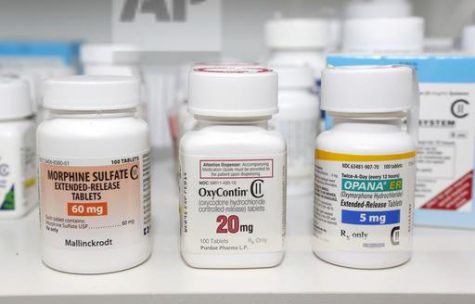The Medicine Cabinet Killer

Hydrocodone pills, also known as Vicodin, a major player in the opioid epidemic. (AP Photo/Toby Talbot)
Opioids: substances that act on opioid receptors to produce morphine-like effects, most often used medically to relieve pain.
Opioids: the current number one cause of accidental death in the the United States.
Opioids: the most accessible gateway drug to heavy substance abuse with chemicals like heroin.
Lori Swanson, Minnesota State Attorney General, issued a report in late November addressing Minnesota’s startling rise in deaths over the last year caused by overdose.
The report’s main focus is on the readily available access to prescription painkillers and the need to develop a process in which doctors review a patient’s drug history before prescribing them medication. These medical background checks could greatly reduce the need for addiction treatment and accidental overdoses across the state.

On November 17th, NPR released a piece with Surgeon General Vivek Murthy, in which he discussed the addiction epidemic that American citizens are facing and what we can do to combat this issue.
“Many — particularly the school-based programs — teach children how to manage stress in a healthy way, because stress is one of the reasons people turn to substances like alcohol, illicit drugs and prescription painkillers. The programs also teach them about substances of misuse, and teach them how to refuse tobacco and alcohol and other illicit substances when they’re offered.”
The school-based programs Murthy is referencing are right here in District 196. Developmental Psychology is one of the main–and most effective–that the district has to offer.
The Developmental Psychology program began in the 1970s at the University of Minnesota. It is a cross-age peer prevention program that pairs select high school seniors with sixth graders at local middle schools for one school year. One to two times a week, the students meet during a flex or homeroom time with their senior teacher and participate in activities, lessons, and discussions about chemical use, stress management, and decision making.
Don Perkins, one of the teachers of the DP program, gave some insight into what exactly the goal of his class is: “The main goal is to educate the district’s sixth graders about making healthy and well-informed decisions, including drugs, bullying, and peer pressure.”
“The key is repeated exposure and open and honest conversations,” says Perkins, a father to three young kids ranging from the ages of seven to ten. “I’ve already begun having discussions with my kids about chemical abuse and knowing the appropriate uses of them, and the consequences of the inappropriate.”
While this program is only in select schools in the country, there is hope for future expansion of similar courses in an effort to curb the alarming amount of growth in substance abuse.
Conversations have been also stirring in the House and Senate about what to do on the legislative level to counter this nationwide epidemic, such as the CARA Legislation, passed by congress in July 2016. CARA would increase prevention, treatment, and recovery programs across the country.
Here at home, the chances of change are looking hopeful, and Lori Swanson is at the front lines of the fight. “We need to stop flooding the population with these medicines in the first place. … They are oral heroin.”






